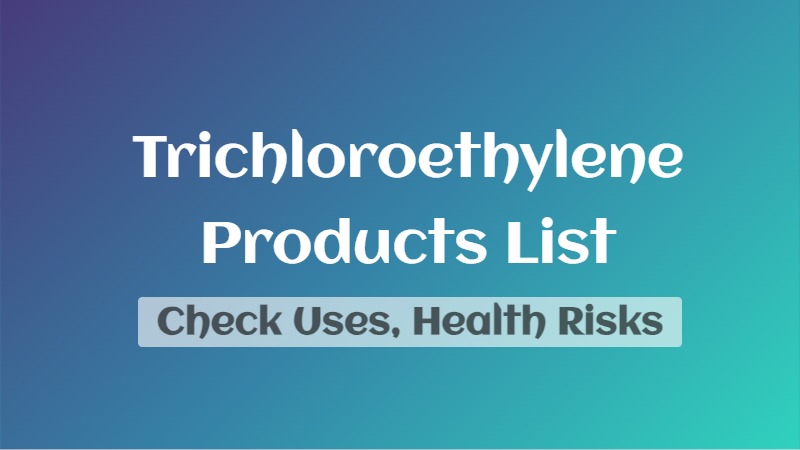
Trichloroethylene (TCE) is a volatile organic compound that has been widely used in various industrial and commercial applications, including as a solvent for cleaning, degreasing, and removing stains. However, due to its potential health and environmental risks, its use has been restricted or banned in many countries. As a result, the availability of TCE products has significantly decreased in recent years.
Here are some examples of products that may have contained trichloroethylene in the past.
Trichloroethylene Products List
- Industrial Solvents: TCE was commonly used as a solvent for various industrial processes, including metal degreasing, precision cleaning, and electronic component manufacturing.
- Paint Strippers: TCE was present in certain paint stripping products used to remove paint and varnish from surfaces.
- Spot and Stain Removers: Some stain removal products, especially those designed for removing tough stains like grease and oil, may have contained TCE.
- Adhesives and Glues: TCE was occasionally used in certain adhesive formulations, including contact adhesives and rubber cements.
- Dry Cleaning Solutions: TCE was once a commonly used solvent in dry cleaning operations. However, its use in this industry has been significantly reduced or replaced with alternative solvents due to health concerns.
- Aerosol Degreasers: Certain aerosol products designed for degreasing and cleaning purposes may have contained TCE.
- Automotive and Metal Cleaners: TCE was utilized in some cleaning products designed for automotive parts, engines, and metal surfaces.
- Printing Inks: In the past, TCE was used in some types of printing inks, particularly those used for lithography and gravure printing.
- Fire Extinguisher Cleaners: TCE was occasionally used as a cleaning agent for certain types of fire extinguishers.
- Adhesive for lace wigs and hair extensions: Tricholoroethylene was commonly used as an adhesive for lace wigs as well as hair extensions.
It’s worth noting that the use of trichloroethylene has been heavily regulated or banned in many countries due to its potential health risks, particularly its association with respiratory, neurological, and developmental effects. Safer alternatives and substitutes have been developed for many of these applications to minimize environmental and health impacts.
About Trichloroethylene
Trichloroethylene (TCE) is a colorless, nonflammable liquid with a characteristic chloroform-like odor. It is practically insoluble in water and evaporates quickly. The most important use of trichloroethylene is the degreasing of metal parts in the automotive and metal industries. Trichloroethylene is used in many consumer products. Examples include typewriter correction fluids, paint removers, paint strippers, adhesives, spot removers, cleaning fluids for rugs, and metal cleaners.
Exposure to Trichloroethylene
Most exposures to trichloroethylene occur in the workplace through breathing vapors or direct contact with the liquid. Exposure of the general public occurs mainly through breathing industrial emissions, drinking, swimming, or showering in water that has been contaminated, or using consumer products containing trichloroethylene. Trichloroethylene has been detected at very low concentrations in many drinking water samples throughout the United States. Trichloroethylene has been detected in low concentrations in many processed foods as a result of its use in cleaning equipment.
Workers and occupational bystanders in TCE manufacturing and processing industries or using commercial products containing TCE are mostly exposed to TCE. Pregnant women/developing fetus/children and those people who depend on water sources contaminated with TCE also faces the exposure to trichloroethylene. Even people that live near industrial or commercial facilities that use TCE are vulnerable.
Health Risks of Trichloroethylene
Inhaling trichloroethylene vapors at very high concentrations may cause irregular heartbeat, heart functions failure, unconsciousness, and death. Inhaling moderate amounts in the air may cause headaches, dizziness, poor coordination, difficulty concentrating, facial numbness, and lung irritation. Consumption of alcohol and exposure to trichloroethylene at the same time can result in “degreaser’s flush”, a temporary redness and itching of the back, neck, and face. Long term exposures at high concentrations may cause liver and kidney damage and changes in heartbeat. Skin contact with trichloroethylene can cause skin rashes.
In a nutshell, Tricholoroethylene is a known human carcinogen moderately persistent in the environment and it can develop immunotoxicity and neurotoxicity.
Cancer Causing Ability of Trichloroethylene
Trichloroethylene is classified as a Group 1 carcinogen by the EPA and IARC (IARC), which means that it is carcinogenic to humans.
Industries using TCE
The following industries use Trichloroethylene which pose various health risks due to its exposure:-
- Vapor degreasing
- Refrigerant manufacturing
- Dry cleaning and laundry
- Clothing or textile treating
- Chemical manufacturing
Protection of Humans from Trichloroethylene
People who work with trichloroethylene are at greatest risk of exposure. If you work somewhere that uses trichloroethylene, follow safe work practices and use appropriate personal protective equipment. For the general public, exposure can be reduced by avoiding products containing trichloroethylene. This includes some paint removers, tool cleaning solutions, carpet cleaners, and spray adhesives.
To get more information on trichloroethylene, read FAQs for Trichloroethylene (TCE) by Agency for Toxic Substances and Disease Registry.










